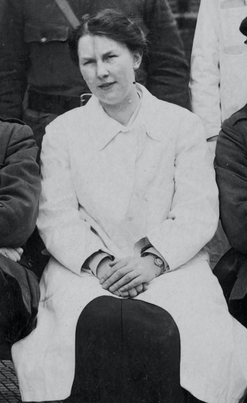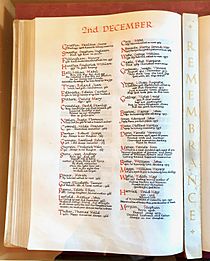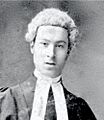Dulcie Mary Pillers facts for kids
Quick facts for kids
Dulcie Mary Pillers
MMAA
|
|
|---|---|

Dulcie Pillers at Beaufort War Hospital in 1918
|
|
| Born | 17 August 1891 St Andrew's, Bristol, England
|
| Died | 2 December 1961 (aged 70) Stoke Bishop, Bristol, England
|
| Alma mater | Kensington Government School of Art, Berkeley Square, Clifton, Bristol, England |
| Known for | Medical illustration |
| Style | Line art, watercolours |
| Patron(s) | Ernest William Hey Groves, Carey Franklin Coombs |
Dulcie Mary Pillers (born August 17, 1891 – died December 2, 1961) was an English medical illustrator. This means she drew pictures for medical books and doctors. She was also a founding member of the Medical Artists Association of Great Britain.
Dulcie was born in Bristol, England. She studied art at the Kensington Government School of Art in Bristol and finished her training in 1911.
During and after World War I, she worked with Ernest William Hey Groves, a famous bone surgeon. She drew many pictures of operations and medical conditions. Her drawings helped doctors understand and teach about surgery. She also created illustrations for other doctors' papers.
In the 1920s, Dulcie was part of the Bristol Venture Club, a group for women who wanted to help their community. She was also a good amateur golfer. Dulcie Pillers passed away in 1961. Her amazing medical artwork is now kept at the Royal College of Surgeons of England.
Contents
Early life
Dulcie Mary Pillers was born on August 17, 1891, in Bristol, England. She was the second daughter of Ernest James Pillers and Elizabeth Scott. Her father was a lawyer in Bristol.
When Dulcie was young, her family faced some challenges. Her father became ill and passed away in 1905. After his death, Dulcie and her family moved to live with her grandparents.
Dulcie was interested in art from a young age. She wrote to the "Children's Corner" section of a local newspaper, the Bristol Times and Mirror. She entered drawing and painting competitions. In 1907, she won second place for her "charming watercolour seascape" and other clever paintings.
Dulcie had a younger brother, Robert Kingsley, who also entered newspaper competitions. He became an automotive engineer and later served in the military, becoming a lieutenant colonel. Her older sister, Irene Dorothy, worked as a government inspector.
Education
Dulcie went to the Kensington Government School of Art in Clifton, Bristol. This school was started in 1890. It taught students how to draw, sculpt, and design. The goal was to train professional artists and art teachers.
At the school, Dulcie took courses in:
- In 1908: Drawing from photos, drawing with light and shadow, and drawing plants from memory.
- In 1909: Painting in one color, drawing models, and painting still lifes.
- In 1911: Shaded drawings from models and solving geometry problems with ink.
She finished school in September 1911. She earned an Art Class Teachers' Certificate. The school later closed in 1914 and became the Municipal School of Industrial Art.
Career as a Medical Illustrator
By 1918, Dulcie Pillers was working as a secretary and medical illustrator for Ernest William Hey Groves. He was a very well-known bone surgeon.
During World War I, Hey Groves worked at Beaufort War Hospital in Bristol. Many soldiers had serious bone injuries from the war. Doctors needed clear pictures to understand these injuries and how to fix them. Back then, cameras couldn't show enough detail inside the body for surgeons. So, medical illustrators like Dulcie were very important. They drew detailed pictures of operations and injuries.
Dulcie helped Hey Groves illustrate his medical papers. She made many drawings and paintings of bone operations. Her work helped other doctors learn new surgical methods. She also contributed to books on physiology (how the body works) and diseases of the heart and joints.
Hey Groves passed away in 1944. He recognized Dulcie's "long and devoted service" by leaving her his patient records and the rights to his important medical textbook. In 1945, this book was updated, and Dulcie added new illustrations to it.
In 1949, Dulcie helped start the Medical Artists Association of Great Britain. This group brought together medical artists from across the country. She became a founding member of this important association.
Personal life
In the 1920s, Dulcie joined the Bristol Venture Club. This was one of the first women's clubs where members were chosen based on their jobs. Dulcie was listed as an "anatomical artist." She was active in the club and helped with their charity work.
Dulcie was also a keen golfer. She was a member of the Bristol and Clifton golf club. She won several medals in club competitions.
Dulcie never married. During World War I, many young men died, which meant fewer men were available for marriage. Also, for some women at that time, having a career like medicine meant staying single.
Death and legacy
Dulcie Pillers passed away on December 2, 1961, at a nursing home in Stoke Bishop, Bristol. Her niece, Elizabeth Mary Marrian, handled her affairs. Elizabeth was also a doctor and a researcher.
Dulcie's artwork is still recognized today. In 1989, her drawings and color illustrations of bone surgery were shown at a big medical conference. In 2013, her niece donated about 25 of Dulcie's illustrations to the Royal College of Surgeons of England. Later, in 2015, more of her illustrations were given to the same archives.
Dulcie's life and work were studied by Samuel Alberti, a museum director. He shared her story in talks and presentations, highlighting her important contributions to medical illustration.
See also
- Audrey Arnott
- Beaufort War Hospital
- Medical Artists' Association of Great Britain
- Medical illustration
- Southmead Hospital
Images for kids




